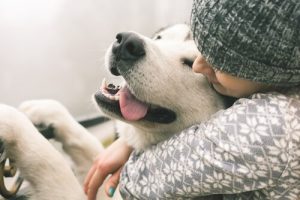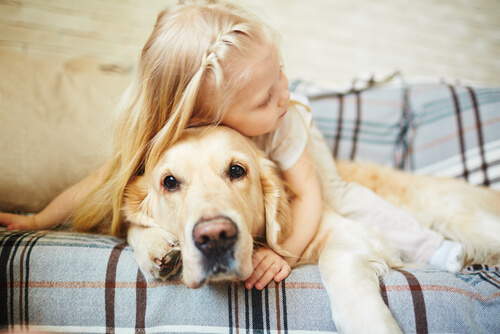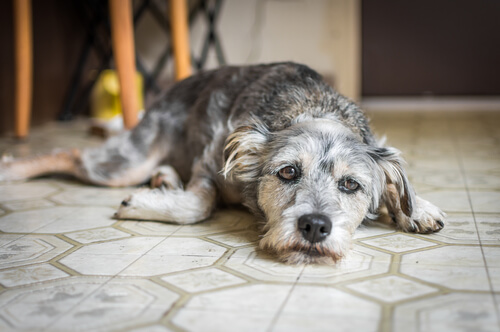Tips on How to Calm a Dog with Anxiety

Fear, Phobias and Anxiety in Dogs
Fear is a response of the autonomic nervous system, the part of the nervous system that controls involuntary actions, unlike the somatic nervous system.
The involuntary response generated by the autonomic nervous system can cause a “fight or flight” response. It can also trigger paralysis, a physiological response to an attack or imminent threat.
Your dog’s body triggers this type of behavior to keep them alive in dangerous situations. When they’re afraid, their body reacts by preparing to fight or flee as quickly as possible.
When the fear persists or is only triggered by one specific stimulus, then we’re entering into the realm of phobias. Sometimes even just places and things related to the phobia will trigger a response in the dog.

What triggers anxiety is the anticipation of future unknown or imagined dangers. It unleashes physical and psychological reactions related to fear. Anxiety in dogs usually happens when they’re separated from their owners for an extended period of time.
Causes and Symptoms Related to Anxiety
Each dog’s fears and phobias have a subjective character that makes them hard to classify. That said, here are some of the most common causes:
- Suffering from a disease or painful injury can increase an animal’s anxiety levels and contribute to the development of fears, phobias or anxieties.
- An imbalance in the nervous system caused by age or infectious diseases of the central nervous system can lead to behavioral issues, including fears, phobias and anxiety.
- A particularly traumatic experience can leave an imprint on the animal’s psyche. Then anxiety attacks in similar situations or places — or around similar people — could result.
- Isolation or mistreatment of puppies under 14 weeks of age can affect their personality. They could become nervous animals prone to panic attacks or anxiety.
- Repeated abandonment of an animal often results in separation anxiety. This problem is very common in animals that have been in and out of shelters.

If your dog’s past includes any of the above, they will be more likely to develop a fearful and dependent personality. Anxiety attacks may occur at some point in their life. Identifying it right away when it’s happening could save your dog’s life.
- Fear and shock can manifest in shaking, loss of energy, and a tendency to run away.
- If your dog is panicked, they will run to safety and possibly develop self-destructive behaviors.
- In extreme cases, there could be a reaction from the sympathetic nervous system, which is part of the autonomic nervous system we mentioned. Diarrhea and urinary incontinence are the most typical external signs.
Treatment and Prevention of Anxiety in Dogs
Very few people know that the vet can diagnose anxiety in dogs and that there is medication available to treat the symptoms. If the problem doesn’t go away and is endangering your dog’s life, go to the vet.
The simplest method of prevention is to not expose your pet to situations or things that have previously triggered anxiety. If exposure is inevitable, try to calm your dog down by petting them, giving them treats, and getting them away from the source of stress as soon as possible.
Fear, Phobias and Anxiety in Dogs
Fear is a response of the autonomic nervous system, the part of the nervous system that controls involuntary actions, unlike the somatic nervous system.
The involuntary response generated by the autonomic nervous system can cause a “fight or flight” response. It can also trigger paralysis, a physiological response to an attack or imminent threat.
Your dog’s body triggers this type of behavior to keep them alive in dangerous situations. When they’re afraid, their body reacts by preparing to fight or flee as quickly as possible.
When the fear persists or is only triggered by one specific stimulus, then we’re entering into the realm of phobias. Sometimes even just places and things related to the phobia will trigger a response in the dog.

What triggers anxiety is the anticipation of future unknown or imagined dangers. It unleashes physical and psychological reactions related to fear. Anxiety in dogs usually happens when they’re separated from their owners for an extended period of time.
Causes and Symptoms Related to Anxiety
Each dog’s fears and phobias have a subjective character that makes them hard to classify. That said, here are some of the most common causes:
- Suffering from a disease or painful injury can increase an animal’s anxiety levels and contribute to the development of fears, phobias or anxieties.
- An imbalance in the nervous system caused by age or infectious diseases of the central nervous system can lead to behavioral issues, including fears, phobias and anxiety.
- A particularly traumatic experience can leave an imprint on the animal’s psyche. Then anxiety attacks in similar situations or places — or around similar people — could result.
- Isolation or mistreatment of puppies under 14 weeks of age can affect their personality. They could become nervous animals prone to panic attacks or anxiety.
- Repeated abandonment of an animal often results in separation anxiety. This problem is very common in animals that have been in and out of shelters.

If your dog’s past includes any of the above, they will be more likely to develop a fearful and dependent personality. Anxiety attacks may occur at some point in their life. Identifying it right away when it’s happening could save your dog’s life.
- Fear and shock can manifest in shaking, loss of energy, and a tendency to run away.
- If your dog is panicked, they will run to safety and possibly develop self-destructive behaviors.
- In extreme cases, there could be a reaction from the sympathetic nervous system, which is part of the autonomic nervous system we mentioned. Diarrhea and urinary incontinence are the most typical external signs.
Treatment and Prevention of Anxiety in Dogs
Very few people know that the vet can diagnose anxiety in dogs and that there is medication available to treat the symptoms. If the problem doesn’t go away and is endangering your dog’s life, go to the vet.
The simplest method of prevention is to not expose your pet to situations or things that have previously triggered anxiety. If exposure is inevitable, try to calm your dog down by petting them, giving them treats, and getting them away from the source of stress as soon as possible.
All cited sources were thoroughly reviewed by our team to ensure their quality, reliability, currency, and validity. The bibliography of this article was considered reliable and of academic or scientific accuracy.
- Mentzel, R. E. (2006). Fisiopatología, diagnóstico y tratamiento de la ansiedad por separación en el perro. Clínica veterinaria de pequeños animales, 26(4), 0329-334.
- Pérez Rossi, A. L. (2017). Ansiedad por separación de caninos. (Tesis de Grado, Universidad de la República Uruguay)
- Talegón, M. I., & Delgado, B. A. (2009). Síndrome de Ansiedad por Separación. Canis et felis, (100), 76-81.
- Mentzel, R., & Snitcofsky, M. (2018). Eto-neuro-inmuno-endocrinología de los trastornos de ansiedad en caninos y felinos. Anuario de Investigación USAL, (4).
This text is provided for informational purposes only and does not replace consultation with a professional. If in doubt, consult your specialist.








